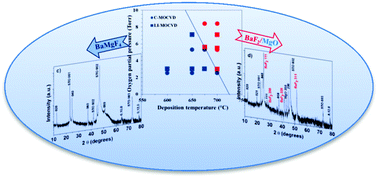The quest towards epitaxial BaMgF4 thin films: exploring MOCVD as a chemical scalable approach for the deposition of complex metal fluoride films†
Abstract
Conventional and Pulsed Liquid Injection MOCVD processes (C-MOCVD and PLI-MOCVD) have been explored as synthetic routes for the growth of BaMgF4 on Si (100) and single crystalline SrTiO3 (100) substrates. For the two applied approaches, the volatile, thermally stable β-diketonate complexes Ba(hfa)2tetraglyme and Mg(hfa)2(diglyme)2(H2O)2 have been used as single precursors (C-MOCVD) or as a solution multimetal source (PLI-MOCVD). Structural characterization through X-ray diffraction (XRD) measurements and transmission electron microscopy (TEM) analyses confirmed the formation of epitaxial BaMgF4 films on SrTiO3 substrates. Energy dispersive X-ray (EDX) analyses have been used to confirm composition and purity of deposited films. The impact of process parameters on film properties has been addressed, highlighting the strong influence of precursor ratio, deposition temperature and oxygen partial pressure on composition, microstructure and morphology of the films. Both methods appear well suited for the growth of the BaMgF4 phase, but while PLI-MOCVD yields a more straightforward control of the precursor composition that reflects on film stoichiometry, C-MOCVD provides easier control of the degree of texturing as a function of temperature.



 Please wait while we load your content...
Please wait while we load your content...